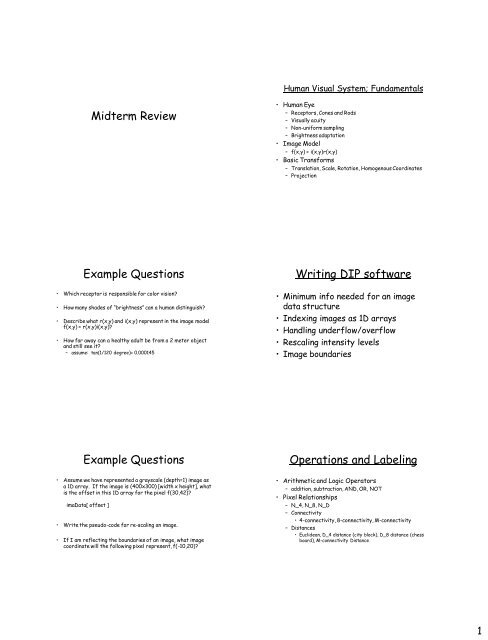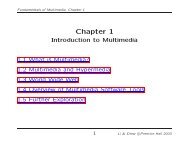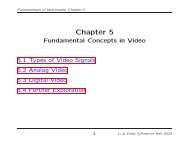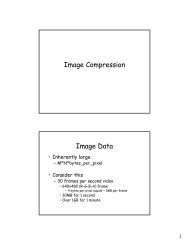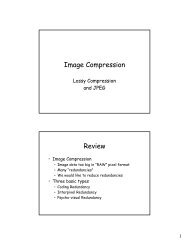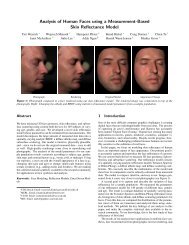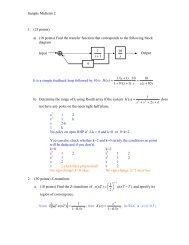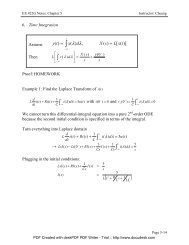You also want an ePaper? Increase the reach of your titles
YUMPU automatically turns print PDFs into web optimized ePapers that Google loves.
Human Visual System; Fundamentals<strong>Midterm</strong> <strong>Review</strong>• Human Eye– Receptors, Cones and Rods– Visually acuity– Non-uniform sampling– Brightness adaptation• Image Model– f(x,y) = i(x,y)r(x,y)• Basic Transforms– Translation, Scale, Rotation, Homogenous Coordinates– ProjectionExample Questions• Which receptor is responsible for color vision?• How many shades of “brightness” can a human distinguish?• Describe what r(x,y) and i(x,y) represent in the image modelf(x,y) = r(x,y)i(x,y)?• How far away can a healthy adult be from a 2 meter objectand still see it?– assume: tan(1/120 degree)= 0.000145Writing DIP software• Minimum info needed for an imagedata structure• Indexing images as 1D arrays• Handling underflow/overflow• Rescaling intensity levels• Image boundariesExample Questions• Assume we have represented a grayscale (depth=1) image asa 1D array. If the image is (400x300) [width x height], whatis the offset in this 1D array for the pixel f(30,42)?imaData[ offset ]• Write the pseudo-code for re-scaling an image.• If I am reflecting the boundaries of an image, what imagecoordinate will the following pixel represent, f(-10,20)?Operations and Labeling• Arithmetic and Logic Operators– addition, subtraction, AND, OR, NOT• Pixel Relationships– N_4, N_8, N_D– Connectivity• 4-connectivity, 8-connectivity, M-connectivity– Distances• Euclidean, D_4 distance (city block), D_8 distance (chessboard), M-connectivity Distance1
Example QuestionsA B CA and B are binary images (black=1 and white=0)Draw C, where C= ((NOT A) OR B)p1p2p3 p4p5p6 p7What is the D_4 (city-block) distance between p1 and p5?Draw the “connections” (links) between the pixels using M-connectivity.How many blobs are there using N-8 connectivity?Geometric Transforms• 2D Transformations– Affine• Properties– maps lines to lines– Preserves lines, equispaced points, incident– Usefulness» Maps triangle to triangle between source anddestination spaces– Projective• Properties– Preserves incident, maps lines-to-lines» Maps general quadrilaterals between source anddestination spacesGeometric Transforms• Image Transformation– Forward Mapping– Reverse Mapping• Sampling and Reconstruction– Aliasing– Fourier Transform• Be able to perform a Fourier transform such as theone we did in class (1-D continuous case)• Formula for Magnitude and Phase-shift• Fourier PairsGeometric Transforms• Convolution identity between F(u) and f(x)• Convolution example• Convolution, Sampling and Filtering– Nyquist Rate– Reconstruction• Multiplying with a filter in frequency domain =convolution with the filters Fourier transform in thespatial domainExample Questions• How many points are necessary to determine anaffine transformation between source anddestination space?• Is the following concatenated matrix affine orprojective?– A = R S Sh T• where R is a rotation, S is a scale, Sh is a shear, and T is atranslation• Demonstrate what is meant by incident preserving?Is a projective transformation incident preserving?Example Questions• Give the formulas to compute the magnitude andphase-shift of the Fourier transform?• Perform a Fourier transform for a given function(such as the one in class)• Explain the nyquist rate?• Consider that we have performed a Fouriertransform on a continuous function f(x) anddetermined the highest frequency to be W=1.5, atwhat interval should we sample the original signal?That is, what should Dx be?2
Example Questions• Draw the result of convolving thefollowing functions.1-202-B BAIntensity Transformations• Point-processing– s = T(r)– Image Histogram• Simple Transformations– Contrast Stretching/Compression– Windowing– Properties of T(r)– Gray-level Slicing• Histograms– What they tell you about an image• Low contrast, High contrast, Bright ImageIntensity Transformations• Histogram Equalization– Formula for Discrete Case• Properties• Histogram Specification• Local Histogram Equalization• Processing based on averagingExample Questions• Explain how image averaging works. What is the main ideabehind this procedure?• Consider an image with gray-levels between 0 and 100. Drawthe “windowing” transform s=T(r) that preserves the graylevelsbetween 30 and 60 (inclusive), and makes all othergray-levels black.• Describe how local histogram equalization is performed.• Is a histogram equalization transform invertible?• What is the formula to compute the transformation T(r) inorder to perform histogram equalization?Example Questions• What is the histogram for the following imagewith gray levels from rk = 0 to 7? [(You may drawthis, un-normalized, ie, n*p(rk) ]2 2 4 4 42 2 0 0 01 2 3 4 12 7 5 6 1Spatial Domain Filtering• Neighbor operators with “masks”– Convolution in the spatial domain• Smoothing Filter (Low Pass)– Blurring– Requirements for mask– Non-linear smoothing filters• Kth nearest neighbor• Max Homogeneity Smoothing• Median Filter– Iterative application of filters and convergence3
Spatial Domain Filtering• Sharpening filters (Hi-pass)– Mask formation– Hipass = Original – Lowpass– High-boost filter• Derivative filters– Filter Criteria (coefficients must sum to 0)– Also sharpens– First Order• Gradient• Gradient Magnitude– Sobel and Prewitt operatorsExample Questions• What is the criteria for constructing a smoothing filter “mask”?• If you perform a gaussian blur over and over, what should youexpect to happen to the output image?• Apply the following filter to the marked pixel,2 2 4 4 42 2 0 0 01 2 3 4 12 7 2 6 21/9 *1 1 11 1 11 1 1What is the resultingnew value?Example Questions• What is the criteria for a sharpening filter?• What is the criteria for a derivative filter?• Draw the 3x3 Sobel and Prewitt Operators.• Give the formula to compute the gradientmagnitude?Example Questions• Is this a valid derivative filter?0 0 -13 0 -10 0 -1• Is this a valid smoothing filter?3 2 -11 1 13 2 3Frequency Domain FilteringFrequency Domain Filtering• Butterworth Filter (High-pass)• High-Boost filter• Homomorphic Filter– f(x,y) = i(x,y)r(x,y)– Filter pipe-line– Variation to control the filter at a certain D 0• Discrete Fourier Transform– Definition• Properties– Image Power Calculation• Ideal Filters– High-pass– Low-pass• Butterworth Filter (Low-pass)– Definition– Definition– Variation to control the filter at a certain D 04
Example Questions• What is the formula for a low-pass 2D Butterworth filter?– Modify this filter such that H(u,v) = 1/sqrt(2) at the cut-offfrequency D 0 (u,v).• Describe the procedure for performing the Homomorphicfrequency domain filter.FFT• What is FFT• Butterfly Graph• Separability of 2D FFT• If we have N samples, at what u in F(u) will we find thehighest possible frequency of f(x)?• What is the formula to compute the Image Power?• What does F(0,0) tell you about the image?Example Questions• Construct a 4-point FFT<strong>Midterm</strong>• These are sample questions– Expect similar questions, but perhaps slightlymore challenging• Format:– 10 short answer– 3 long questions• Long questions may be composed of several parts• More like “theme” questionsExtra Credit from 2006• These four images shown are blurred using square averaging masks of size n = 1(original image), 15, 25, and 45 respectively. The vertical bar on the lower part of (b)and (d) are blurred, but a clear separation exists between them. However they havemerged in image (c), in spite of the fact that the mask that produced this image issignificantly smaller than the masked that produced image (d), explain thisExtra Credit from Last Year• High-pass filtering:5


